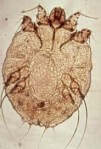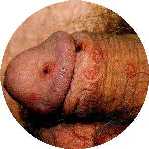 Scabies, along with lice, are the cause of the most frequent skin infections in North America. Scabies is caused by a parasite ... a mite that is invisible to the naked eye: Sarcoptes scabei. This bug lives and feeds in the upper layers of the skin, where it burrows around and lays its eggs.  Scabies are transmitted in much the same fashion as lice; the infection can spread through sexual intercourse, but this isn't necessary; any close contact will have the same result. In fact, scabies often spread from person to person in closed environments such as schools, day care centres and nursing homes. Scabies are transmitted in much the same fashion as lice; the infection can spread through sexual intercourse, but this isn't necessary; any close contact will have the same result. In fact, scabies often spread from person to person in closed environments such as schools, day care centres and nursing homes.
The female mite penetrates the skin, burrows in and begins to lay eggs ... up to three per day. It's the eggs in the skin that cause an inflammation similar to an allergic reaction; the result for the person infected is extreme itchiness. When the eggs hatch, the larvae grow into adult mites and start a new life cycle. An individual female mite can continue laying eggs for up to five weeks.  The itchiness will begin in folds of skin all over the body, but most especially in the armpits, buttocks and groin. The itching is usually worse at night. You can see tiny burrows between the fingers, on the wrists and on the ankles, each several millimetres long, where the parasite has been travelling under the surface of the skin. Tiny bumps may be visible on or near the armpits, breasts, buttocks and genital organs; this is an allergic reaction to eggs laid by the mites. Diagnosis of this type of infection can be difficult, as the symptoms are similar to other skin problems, notably eczema, and the mites and eggs are too tiny to see. However, microscopic analysis of skin from the infected locations may reveal the parasite, its eggs or feces. There are effective lotions, creams and shampoos that a doctor can prescribe. It is important to change into clean clothes immediately after treatment in order to avoid recontamination. Contaminated clothing, bedding, towels and toiletries need to be washed for about half an hour in very hot water. The treatment may need to be repeated a week later to kill any mites that have hatched from eggs since the first treatment, as the eggs are not always killed. GONORRHEA | GENITAL WARTS | LICE & CRABS | SCABIES | HEPATITIS | HIV/AIDS |